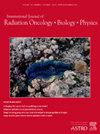纵向动态磁共振成像放射组学模型用于早期预测同期化疗的局部晚期宫颈癌患者的预后
IF 6.4
1区 医学
Q1 ONCOLOGY
International Journal of Radiation Oncology Biology Physics
Pub Date : 2024-10-01
DOI:10.1016/j.ijrobp.2024.07.046
引用次数: 0
摘要
目的 研究基线和治疗期间获得的基于动态磁共振成像(MRI)的放射组学对接受同期化放疗(CCRT)治疗的局部晚期宫颈癌(LACC)患者的病情进展和预后的早期预测价值。材料/方法本研究回顾性纳入了2017年3月至2021年12月期间接受同期化放疗后近距离放疗的111例LACC患者(FIGO 2018分期ⅡA- IVA)。动态 MRI 图像在近距离治疗前(MRIpre)和每次随访时获得。随访期间记录了临床特征、2 年无进展生存期(PFS)和 2 年总生存期(OS)。为建立预后模型,88 名患者被随机分为训练集,其余 23 名患者保留为测试集。应用最小绝对收缩和选择算子(LASSO)方法从磁共振成像图像和临床特征中提取特征。结果中位随访时间为 4.3 年(IQR = 3.1-5.0),2 年 PFS 为 73.9%,2 年 OS 为 82.9%。从原始图像和小波滤波图像中共提取了842个放射组学特征。与单序列模型相比,使用T1对比和DWI序列磁共振成像的多序列模型表现出更优越的性能,在测试集上获得了更高的AUC分数(表)。利用MRIpre、MRIpost和ΔMRI(MRIpre和MRIpost的放射组学特征的变化)的放射组学特征建立的模型在测试集上的2年PFS和2年OS的AUC得分分别为0.723、0.750和0.759,以及0.711、0.737和0.716。结论在这项研究中,我们利用纵向图像中的动态特征建立了机器学习模型,发现利用多序列 MRI 图像中的放射组学特征(ΔMRI)变化建立的模型在预测 LACC 患者的预后方面具有显著的前景。与临床特征相结合的模型进一步提高了预测性能。本文章由计算机程序翻译,如有差异,请以英文原文为准。
Longitudinal Dynamic MRI Radiomic Models for Early Prediction of Prognosis in Locally Advanced Cervical Cancer Treated with Concurrent Chemoradiotherapy
Purpose/Objective(s)
To investigate the early prediction value of dynamic magnetic resonance imaging (MRI)-based radiomics acquired at baseline and during treatment for progression and prognosis in locally advanced cervical cancer (LACC) patients treated with concurrent chemoradiotherapy (CCRT).
Materials/Methods
A total of 111 LACC patients (FIGO 2018 stages ⅡA- IVA) who received CCRT followed by brachytherapy between March 2017 and December 2021 were retrospectively enrolled in this study. The dynamic MRI images were acquired at baseline (MRIpre) before brachytherapy delivered (MRIpost) and at each follow-up visit. Clinical characteristics, 2-year progression-free survival (PFS), and 2-year overall survival (OS) were recorded during follow-up. To build the prognostic model, 88 patients were randomly divided into a training set, and the rest 23 patients reserved for the test set. The least absolute shrinkage and selection operator (LASSO) method was applied to extract features from MRI images as well as from clinical characteristics. Vector Machine (SVM) model was trained using 5-Fold cross-validation on the training set and then evaluated on the test set.
Results
The median follow-up was 4.3 years (IQR = 3.1-5.0), 2-year PFS was 73.9%, and 2-year OS was 82.9%. A total of 842 radiomics features were extracted from both original and wavelet-filtered images. Multi-sequence models using T1 contrast and DWI-sequence MRI exhibited superior performance, achieving higher AUC scores on the test set compared to single-sequence models (Table). Models built by the radiomics features from MRIpre, MRIpost and theΔMRI (variations in radiomics features from MRIpre and MRIpost) achieves AUC scores of 0.723,0.750 and 0.759 for 2-year PFS, and 0.711, 0.737, and 0.716 for 2-year OS on the test set. When combined with the clinical characteristics, the predictive model using ΔMRI features achieved higher AUC scores than MRIpre or MRIpost model, with AUC of 0.812 for the progression and 0.816 for the survival.
Conclusion
In this study, we built machine learning models from dynamic features in longitudinal images, finding the models using variations in radiomics features (ΔMRI) from multi-sequence MRI images hold significant promise for predicting the prognosis of LACC patients. The integrated models with clinical characteristics further enhanced the predictive performance.
求助全文
通过发布文献求助,成功后即可免费获取论文全文。
去求助
来源期刊
CiteScore
11.00
自引率
7.10%
发文量
2538
审稿时长
6.6 weeks
期刊介绍:
International Journal of Radiation Oncology • Biology • Physics (IJROBP), known in the field as the Red Journal, publishes original laboratory and clinical investigations related to radiation oncology, radiation biology, medical physics, and both education and health policy as it relates to the field.
This journal has a particular interest in original contributions of the following types: prospective clinical trials, outcomes research, and large database interrogation. In addition, it seeks reports of high-impact innovations in single or combined modality treatment, tumor sensitization, normal tissue protection (including both precision avoidance and pharmacologic means), brachytherapy, particle irradiation, and cancer imaging. Technical advances related to dosimetry and conformal radiation treatment planning are of interest, as are basic science studies investigating tumor physiology and the molecular biology underlying cancer and normal tissue radiation response.

 求助内容:
求助内容: 应助结果提醒方式:
应助结果提醒方式:


